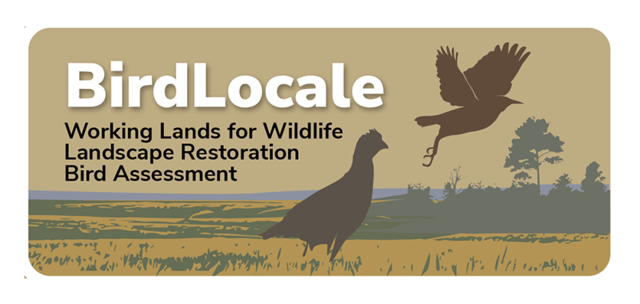-
 Southern Front Range Watershed
Southern Front Range Watershed
-
by
Rhishja Cota
—
published
Oct 27, 2022
—
filed under:
Wildland Fire,
Research
The Southern Front Range (SFR-JCLRP) project will treat vegetation in the project area within Pueblo, Custer, Huerfano, and Las Animas counties. Treatments would be adjacent to or near the towns of Cuchara, Aguilar, Stonewall, Wetmore, Westcliffe, Beulah, and Rye, Colorado.
Located in
Resources
/
…
/
Projects
/
Fire-Community & Infrastructure
-
 The Effects of Livestock Grazing on the Bog Turtle
The Effects of Livestock Grazing on the Bog Turtle
-
by
Rhishja Cota
—
published
Nov 08, 2022
—
last modified
Jul 24, 2023 11:27 AM
—
filed under:
Reptile,
Additional Resources,
Livestock,
Habitat loss,
Bog Turtle,
Product,
Research,
Peer-reviewed Science,
Aquatics,
Bog Turtle Additional Resources,
Grazing,
Resources
The demise of small-scale dairy farming over the past three decades has led to the pastoral abandonment of the majority of bog turtle habitats in the Northeast. As a consequence, habitats are being degraded by the growth of invasive flora, changes in hydrology, and the loss of turtle microhabitats created by livestock.
Located in
Information Materials
/
Research
/
Peer-reviewed Science
-
 The GigaFire Project
The GigaFire Project
-
by
Rhishja Cota
—
published
Nov 02, 2022
—
filed under:
Remote Sensing,
Research,
Fire Mapping,
Water Quality,
Wildland Fire,
Projects,
Ladder Fuels
The GigaFire Project is a set of interconnected research projects focused on quantifying the state and dynamics of wildland fuels as well as the impacts of varying fuel managements on fire severity, long-term carbon sequestration, and water quality.
Located in
Resources
/
…
/
Projects
/
Fire Mapping/Remote Sensing
-
 The use of nest boxes by the hellbender salamander in Western North Carolina
The use of nest boxes by the hellbender salamander in Western North Carolina
-
by
Morgan Harris
—
published
Aug 10, 2020
—
last modified
Jul 26, 2023 01:32 PM
—
filed under:
Artificial Next Box Research,
Additional Resources,
Eastern Hellbender Additional Resources,
Research,
Aquatics,
Resources
The hellbender salamander (Cryptobranchus alleganiensis) is a unique, large-bodied amphibian that serves as an excellent water quality indicator species in Western North Carolina. This animal has suffered substantial population declines over the past four decades throughout its range. Increased stream siltation largely attributed to human development fills the concave undersides of large rocks, consequently destroying hellbender breeding habitat. Habitat degradation has contributed to reductions in North Carolinian populations to such a degree that the species is now considered of Special Concern in the state. In order to restore hellbender population sizes under current land use conditions, researchers have recently begun developing artificial nest boxes that exclude sediment and promote increased reproduction. To identify the short-term efficacy of these shelters as substitutes for natural hellbender habitat in Western North Carolina, I constructed and placed 54 boxes across five river sites throughout the region. Following summer nest box installment, I examined each shelter through the breeding season for hellbender in habitation and to determine the quality of water passing through the structures. Additionally, I created a maximum entropy species distribution model and conducted a spatial connectivity analysis for the hellbenders of Western North Carolina to identify ideal locations for nest boxes installation in the future. Although no hellbenders have yet been detected in the artificial shelters, additional structural improvements and time may reveal nest boxes to be useful conservation tools for this iconic species of Special Concern.
Located in
Information Materials
/
Research
/
Artificial Nest Box Research
-
 Theory and practice of the hydrodynamic redesign of artifical hellbender habitat
Theory and practice of the hydrodynamic redesign of artifical hellbender habitat
-
by
Morgan Harris
—
published
Aug 10, 2020
—
last modified
Jul 26, 2023 01:34 PM
—
filed under:
Artificial Next Box Research,
Additional Resources,
Eastern Hellbender Additional Resources,
Research,
Aquatics,
Resources
The success of nest boxes in Missouri led researchers to test whether similar management tools could increase C. a. alleganiensis populations in the streams of western North Carolina, where these salamanders are listed as a Species of Special Concern (Messerman 2014). Fifty-four nest boxes were constructed following the boot-shaped design of Briggler and Ackerson (2012) in May 2013, and were installed across five known C. alleganiensis stream sites between late June and early August 2013. Messerman (2014) then monitored each nest box every three to four weeks through November 2013, and the boxes were revisited in August 2014 and July 2015 to observe structural condition and occupancy (Messerman, pers. obs.). Of the 54 nest boxes, only two structures at a single site were confirmed as inhabited in 2014 and 2015, and no breeding events were detected (Messerman, pers. obs.). Moreover, many of these ~50 lb concrete boxes moved in flood events or accumulated sediment at the downstream tunnel entrance (Messerman 2014). The low success of the boot-shaped nest box design in North Carolina may be attributed to the sites generally being narrower and shallower than those in Missouri, with much of the substrate consisting of bedrock slabs covered by relatively thin layers of rock, gravel and silt. Here we address the observed shortcomings of the original North Carolina design through the lens of engineering, and present a new and easily implemented nest box model for use in streams like those found in western North Carolina.
Located in
Information Materials
/
Research
/
Artificial Nest Box Research
-
 Uwharries to Sandhills Landscape Collaborative
Uwharries to Sandhills Landscape Collaborative
-
by
Rhishja Cota
—
published
Oct 27, 2022
—
filed under:
Wildland Fire,
Research
The Uwharries to Sandhills Landscape Collaborative (USLC) will improve forest health by restoring privately and publicly owned pine forests to an open-canopy condition in and around Uwharrie National Forest (UNF), and in a habitat corridor between the Uwharries and the NC Sandhills ecoregion.
Located in
Resources
/
…
/
Projects
/
Prescribed Burn
-
 Valleys and Headwaters Restoration
Valleys and Headwaters Restoration
-
by
Rhishja Cota
—
published
Oct 05, 2022
—
last modified
Nov 10, 2022 02:40 PM
—
filed under:
Wildland Fire,
Research
The project area has been heavily impacted by insects and disease over the last two decades, and more recently by large high-intensity wildfires, including the unprecedented 2020 fire season.
Located in
Resources
/
…
/
Projects
/
Prescribed Burn
-
 Western Fire Chiefs Association (WFCA) Fire Map
Western Fire Chiefs Association (WFCA) Fire Map
-
by
Rhishja Cota
—
published
Nov 02, 2022
—
last modified
Nov 08, 2022 12:22 PM
—
filed under:
Wildland Fire,
Fire Mapping,
Remote Sensing,
Products,
Research
The WFCA Fire Map pulls data from the US Forest Service via National Interagency Fire Center IRWIN feed, and 911 Dispatch data via PulsePoint to track the location of the wildfire as they start and while they’re burning. The WFCA Fire Map is the first map of its kind to pull such data from 911 Dispatch in relevant areas.
Located in
Resources
/
Research
/
Products
-
 WildfireSAFE: Real-Time Data to Improve Wildfire Management
WildfireSAFE: Real-Time Data to Improve Wildfire Management
-
by
Rhishja Cota
—
published
Oct 27, 2022
—
filed under:
Wildland Fire,
Research
WildfireSAFE provides an intuitive platform to access fire weather, hazard and behavior information from the Wildland Fire Assessment System (WFAS) for specific incidents. It supports the greater interagency fire community in the planning, response, and recovery phases of wildfire management.
Located in
Resources
/
…
/
Projects
/
Innovation in Fire Tools, Thinking & Approaches
-
 Wood River Valley Forest Health & Wildfire Resilience
Wood River Valley Forest Health & Wildfire Resilience
-
by
Rhishja Cota
—
published
Oct 27, 2022
—
filed under:
Wildland Fire,
Research
The Wood River Valley Forest Health and Wildfire Resilience Project will reduce the significant wildfire threat to the main populous corridor in Blaine County, Idaho.
Located in
Resources
/
…
/
Projects
/
Fire-Community & Infrastructure


